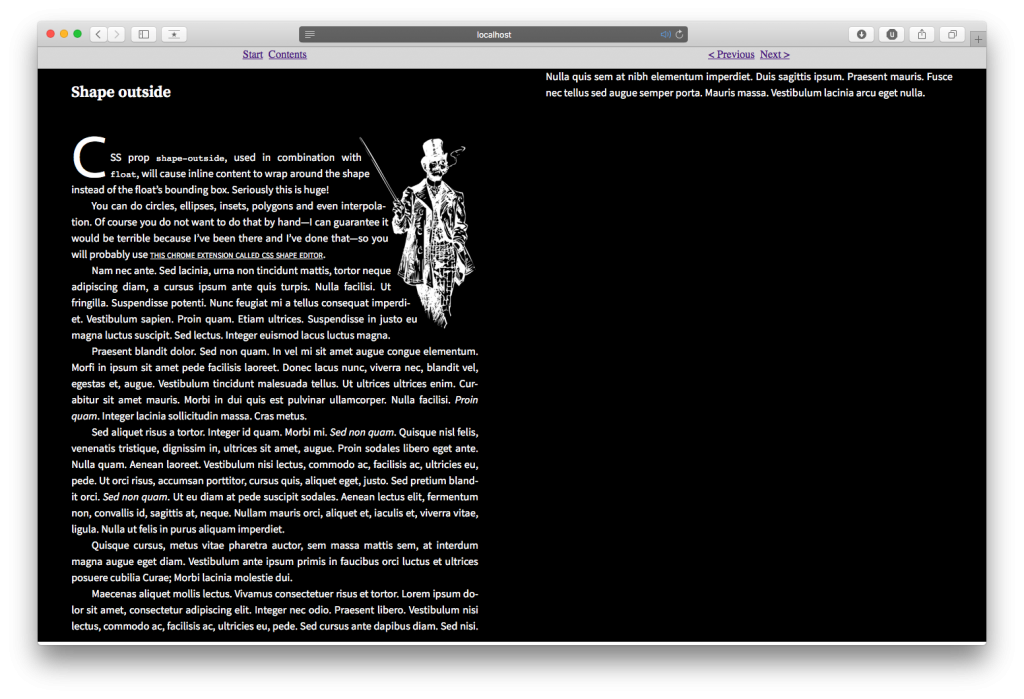We reached our first milestone: a functional prototype. It provides implementers with:
- Support for Latin (LTR, horizontal-writing)
- Basic paged and scroll views
- Basic page margins
- Default stylesheets (base, unstyled EPUBs, highlights)
- User settings:
- night and sepia modes;
- font family;
- font size;
- line-height;
- hyphenation;
- text align;
- paragraphs’ margin;
- text indent;
- letter and word spacing.
Along with a work-in-progress documentation so that developers can take a look and start testing it.
Our first round of testing is promising: rendering is consistent, user settings are reliable—there isn’t a lot of issues to report so far—, we can offer implementers with flexibility since our design approach is strategy-agnostic, and we achieved this in modern and future-proof CSS.
We’d like to take this opportunity to thank the #eprdctn community once again. You provided useful samples and they helped us tremendously.
Implementers, start your (rendering) engines
Although Readium CSS is not production-ready yet, you can at least take a look and maybe experiment with it.
What’s noteworthy:
- we tried to make it JavaScript-friendly;
- we’re trying to make the transition from Readium to Readium CSS as smooth as possible;
- we’ve designed it in a modular way (task-oriented stylesheets), so that you can pick the styles you want to use and generate customized stylesheets out of them;
- user settings are strategy-agnostic, you can manage them as you wish, on both the technical and UX sides;
- everything can be customized;
- it is spec-compliant out of the box (both EPUB 3.1 and CSS snapshot 2017);
- it is designed to be compliant with future specs as well.
Please feel free to weigh in the Github repo issues if you’d like to see any specific issue or feature request addressed.
And if you need help, do not hesitate to reach out to Jiminy Panoz.

We have found ways to reliably darken and invert images in night mode, on user’s demand.
Authors’ feedback
Openness and transparency have been two key values of this project. We’ve been collecting feedback and feature requests from the community, and documenting our every move and design decision.
We want to make sure Readium CSS meets your EPUB expectations, and provides solid interoperability. Please feel free to speak out if you’re concerned about something, or can see room for improvement.
We’ve tried to be conformant with the EPUB specifications to the letter but there are parts for which we must find sensible compromises. Let’s go the extra mile together.

We’re trying to design user settings recommendations so that implementations won’t override your styles unless strictly necessary.
What’s coming next
We’ll focus on testing this prototype, adding support for CJK (Chinese, Japanese and Korean) and RTL (Right-to-left script), and improving paged and scrolled views in the next weeks.
Any feedback and help in those areas will be greatly appreciated. Indeed, we want to get it right so that readers all around the world can feel empowered. And this is the reason why we’ll extend language support as far as we can. But we’ll obviously need your expertise to achieve such a goal.
For your information, our roadmap is publicly available, and we will track progress as regularly as we can.
Stay tuned, the alpha version is coming!













 contact@edrlab.org
contact@edrlab.org +33 1 83 64 41 34
+33 1 83 64 41 34

[…] reached our first milestone a week ago: a functional prototype. Once again, please feel free to weigh in. We’ll take your remarks into account and try to […]
[…] took a few months to go from the prototype to the alpha version but a lot of research and development has been happening behind the scenes, […]